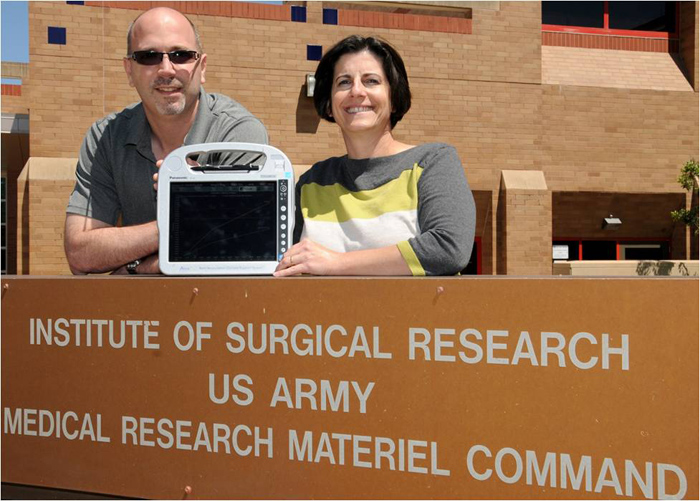USAISR Burn Center Receives FDA Clearance for Burn Resuscitation Technology

For the first time in its 70-year history, the U.S. Army Institute of Surgical Research at Joint Base San Antonio-Fort Sam Houston received 510(k) clearance from the U.S. Food and Drug Administration for a medical device developed at the USAISR. The clearance for the Burn Navigator or Burn Resuscitation Decision Support System-Mobile, or BRDSS-M, was announced by the FDA Director of Preparedness/Operations and Medical Countermeasures at the Center for Devices and Radiological Health Dr. Suzanne Schwartz during the 2013 American Burn Association 45th Annual Meeting at Palm Springs, Calif., April 23-26.
"This technology is the first of its kind algorithm-based decision assist system for use in managing fluid resuscitation of the severely burned patient," said Schwartz. "We consider this a milestone, but even more than that, a peek into what the future has in store for burn trauma management."
USAISR Research Task Area Program Manager for Comprehensive Intensive Care Research Jose Salinas, Ph.D, helped develop the BRDSS algorithm which generates recommendations of fluid intake for burn patients. It was designed to assist in avoiding problems related to over- or under-resuscitating by medical care providers who do not routinely care for burn patients. The original BRDSS technology was developed for use at the USAISR Burn Center Intensive Care Unit about seven years ago. According to Salina, it has been invaluable with assisting medical providers with resuscitation management and has been shown to improve patient outcomes.
"If you give a patient too much or too little fluid, the results can be fatal," explained Salinas, describing the complex care necessary for burn patients who are often dehydrated and require precise rehydration.
Maria Serio-Melvin, MSN, USAISR clinical program coordinator for computer decision support systems and co-chair of the integrated product team that is fielding the system, added that there are a lot of competing priorities when caring for burn patients.
"Our goal is that this device will help keep medical providers on track with one of the most important things that they need to do'hourly fluid titration based on urine output," said Serio-Melvin.
The Burn Navigator is designed to be used in a deployed setting by non-burn experienced nurses and doctors. The software is in a mobile tablet that meets military specifications.
"An additional benefit of the system is that it's not only a decision support system; it's also a graphical interface of the trends of how the patient is doing," said Salinas. "So even without the decision support part of it, medical providers can look at the display and see how the patient is progressing and use that to help better manage the burn patients."
The Burn Navigator is expected to be used soon by the Army at deployed Combat Support Hospitals, which support overseas contingency operations in Iraq and Afghanistan.
The Burn Navigator technology was licensed to Arcos Medical, Inc. of Houston, which worked with the USAISR to submit the FDA 510(k) application with funding from the U.S. Army Medical Research and Materiel Command at Fort Detrick, Md. The USAISR is a subordinate research command of USAMRMC, which is a major command in the Army that leads efforts in support of the full life cycle of medical supplies and equipment, to include research, development, acquisition and sustainment. The research part of the mission is executed through its laboratory commands like the USAISR and extramurally.
Companies such as Arcos, Inc. produce commercial devices, including the Burn Navigator, for use by the Army and at civilian burn centers throughout the world.














